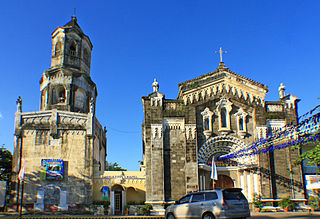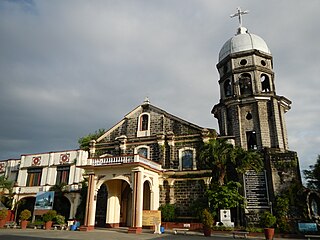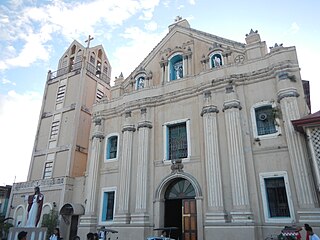
Floridablanca, officially the Municipality of Floridablanca is a 1st class municipality in the province of Pampanga, Philippines. According to the 2020 census, it has a population of 135,542 people. Floridablanca is a part of the province of the Pampanga located in Central Luzon lying north of Dinalupihan, Bataan and south-southwest of San Fernando, Pampanga.

The Santa Monica Parish Church, commonly known as the Minalin Church, is a Baroque Roman Catholic church, located in poblacion area of San Nicolas in Minalin, Pampanga, Philippines. The church, built during the Spanish era, was declared a National Cultural Treasure by the National Commission for Culture and the Arts and the National Museum of the Philippines on August 27, 2011, one of 37 churches in the country bestowed that honor.

San Juan de Dios Parish Church, also San Rafael Church, is an 18th-century Roman Catholic church situated in Brgy. Poblacion, in San Rafael, Bulacan, Philippines. Its titular patron is St. John of God; Saint Raphael, archangel, is the secondary patron saint. It is in this church that the Battle of San Rafael took place, wherein hundreds of retreating Filipino soldiers and civilians lost their lives during a battle with the Spanish on November 30, 1896. A historical marker by the National Historical Commission of the Philippines was installed in front of the church in 1997 to commemorate the massacre of an estimated 800 Filipinos.

Maribojoc Church, also known as Santa Cruz Parish Church or Holy Cross Parish Church, is a Roman Catholic parish church in the municipality of Maribojoc, Bohol, Philippines, under the Diocese of Tagbilaran. The parish was first established by the Jesuits in 1767 or 1768 with Father Juan Soriano, SJ as its first parish priest. The Augustinian Recollects later administered the community until 1898.

La Purisima Concepcion de la Virgen Maria Parish Church, commonly known as Baclayon Church, is a Roman Catholic church in the municipality of Baclayon, Bohol, Philippines within the jurisdiction of the Diocese of Tagbilaran. Baclayon was founded by the Jesuit priest Juan de Torres and Gabriel Sánchez in 1596, and became the oldest Christian settlement in Bohol. It was elevated as a parish in 1717 and the present coral stone church was completed in 1727. The Augustinian Recollects succeeded the Jesuits in 1768 and heavily renovated the church since then.

The San Pedro Apostol Parish Church, commonly known as Loboc Church and alternatively as the Diocesan Shrine of Our Lady of Guadalupe in Extremadura, is a Roman Catholic church in the municipality of Loboc, Bohol, Philippines, within the jurisdiction of the Roman Catholic Diocese of Tagbilaran.

The Diocesan Shrine and Parish of Nuestra Señora de la Asuncion, commonly known as the Bulakan Church, is a 19th-century Neo-Byzantine-Romanesque stone church located at Brgy. San Jose, in the Municipality of Bulakan, Bulacan province, Philippines. It is one of the parishes of the Roman Catholic Diocese of Malolos under the Vicariate of the Immaculate Conception. The church was declared Marked Historical Structure of the Philippines in 2007 by the National Historical Institute, the precursor of the National Historical Commission of the Philippines. A historical marker bearing a brief history of the church was installed by the commission.

The Saint Agustine Parish Church, also known as the Lubao Church, is a 17th-century Neo-classic, Spanish stone and brick church located at Brgy. San Nicolas 1st, Lubao, Pampanga, Philippines. In 1952, a historical marker bearing a brief history of the structure was installed on the facade of the church by the Historical Committee of the Philippines, precursor of the National Historical Commission of the Philippines. In 2013, the church has been declared by the National Museum of the Philippines as an Important Cultural Property.

The Immaculate Conception Parish Church, also known as the Parroquia de la Inmaculada Concepcion de Guagua and Guagua Church, is a 17th-century Baroque church located at Brgy. Plaza Burgos, Guagua, Pampanga, Philippines. In 1982, a historical marker bearing the brief history of the church was installed on the facade by the church by the National Historical Committee, precursor of the National Historical Commission of the Philippines. Today, the church is under the care of the Immaculate Conception parish of the Roman Catholic Archdiocese of San Fernando.

The Saint Catherine of Alexandria Parish Church, also known as the Porac Church, is a 19th-century Baroque Roman Catholic church located at Barangay Poblacion, Porac, Pampanga, Philippines. The parish church is currently under the ecclesiastical province of the Archdiocese of San Fernando.

The San Nicolas de Tolentino Parish Church, commonly known as Macabebe Church, is a 17th-century, Baroque Roman Catholic church located at Barangay Santa Cruz, Macabebe, Pampanga, Philippines. The parish church, under the patronage of Saint Nicholas of Tolentine, is under the Archdiocese of San Fernando.

The San Andres Apostol Parish Church, commonly referred to as Candaba Church, is a 17th-century, Baroque church located at Barangay Pescadores, Candaba, Pampanga, Philippines. The parish church, dedicated to Saint Andrew the Apostle, is under the Roman Catholic Archdiocese of San Fernando.

The Nuestra Señora del Pilar Parish Church, also known as the San Simon Church, is a 19th-century Baroque Roman Catholic church located at Barangay San Juan, San Simon, Pampanga, Philippines. The parish church, under the protection of its patron saints, the Virgin of the Pillar and Saint Peter, is under the Archdiocese of San Fernando.

The San Lorenzo de Roma Parish Church, also known as the Saint Lawrence, Deacon and Martyr Parish Church or simply, Balagtas Church, is an 18th-century Baroque Roman Catholic church located at Brgy. Longos, Balagtas, Bulacan, Philippines. The parish church, dedicated to Saint Lawrence, is under the jurisdiction of the Diocese of Malolos.

The Saint Vincent Ferrer Parish Church, also known as Bayambang Church, is a Roman Catholic church located in the municipality of Bayambang in Pangasinan, Philippines. It is under the jurisdiction of the Archdiocese of Lingayen-Dagupan. The parish church celebrated its quadricentennial year in April 2019, coinciding with the completion of the 50.23-metre (164.8 ft) St. Vincent Ferrer Statue.

The Saint Ildephonse of Seville Parish Church, also known as Malasiqui Church, is a Roman Catholic church in Malasiqui, Pangasinan in the Philippines. It was formerly a chapel under the parish of San Carlos. Father Juan Camacho was appointed first kura paroko and founded the parish in 1665. The 1660 Revolt caused the transfer from San Carlos to its present site at the town of Malasiqui in 1661–1662. The church celebrates its feast every January 23.

The Diocesan Shrine and Parish of San Andres, popularly known as Masinloc Church, is an 18th-century Baroque Roman Catholic church located at Brgy. South Poblacion, Masinloc, Zambales, Philippines. The parish church, dedicated to Saint Andrew the Apostle, is under the jurisdiction of the Roman Catholic Diocese of Iba. The church structure, a standout among Spanish-era churches in the Central Luzon region for having been built with coral stone instead of adobe stone, was declared a National Cultural Treasure by the National Museum of the Philippines along with 25 other Spanish-era churches in 2001.

The San Ignacio de Loyola Parish Church, commonly known as Capul Church or Fuerza de Capul, is a Roman Catholic fortress church in the municipality of Capul, Northern Samar, Philippines within the jurisdiction of the Diocese of Catarman. It was first established as a mission station by the Jesuits in 1596 under the advocacy of Saint Ignatius of Loyola.

Tagbilaran Cathedral, officially named as the Diocesan Shrine and Cathedral-Parish of Saint Joseph the Worker, is a Roman Catholic cathedral in Tagbilaran, capital city of Bohol province, in Central Visayas, Philippines. It is the seat of the Diocese of Tagbilaran which comprises Bohol's western half. The cathedral is located in Tagbilaran poblacion and was installed with a historical marker by the NHCP in 1953.























